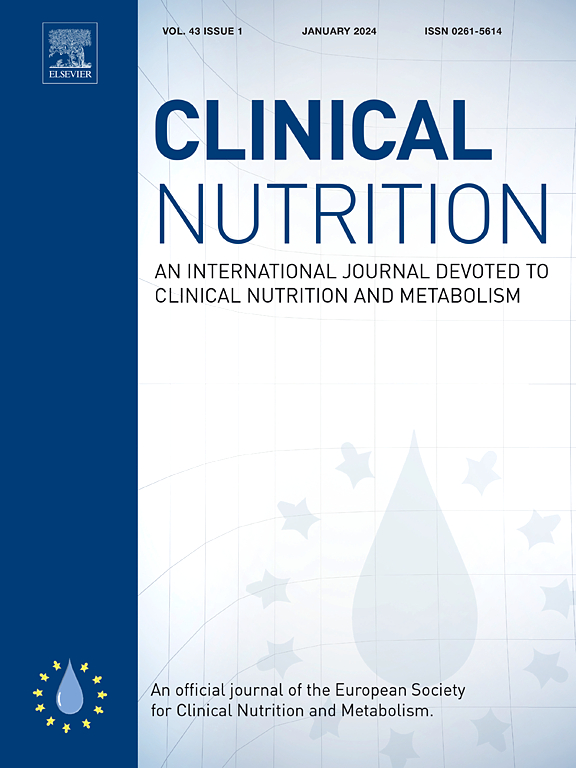乳素和纯素饮食对健康成人血糖反应和代谢物谱的影响:一项使用连续血糖监测和靶向代谢组学的随机试验
IF 6.6
2区 医学
Q1 NUTRITION & DIETETICS
引用次数: 0
摘要
我们之前的研究表明,乳制品可以预防2型糖尿病(T2D)并改善心脏代谢健康结果。鉴于连续血糖监测(CGM)和代谢组学分析捕获了T2D的不同方面,本研究调查了乳制品和非乳制品对健康成人遵循乳素和纯素饮食的血糖和代谢物谱的影响。方法对30名参与者进行平行随机喂养试验,比较等能纯素和乳素饮食。所有参与者佩戴CGM传感器14天,以跟踪葡萄糖浓度。还测量了人体测量和生化特性。在13人的亚组中,在第1天和第15天收集空腹和餐后血液样本进行代谢组学分析。我们的CGM数据显示,在调整了年龄、性别、体重指数和基线葡萄糖浓度后,素食组在14天内的平均葡萄糖浓度高于乳素食组(p = 0.0399)。从第1天到第15天的代谢组学分析显示,餐后苯丙氨酸(Phe;p = 0.0189),而乳素组乙酰肉碱增加(C2;P = 0.00704),精氨酸琥珀酸降低(P = 0.0149)。我们的试验CGM数据表明,乳素饮食可能提供更好的血糖控制,这可能是我们初步代谢组学研究结果的解释。在纯素组中观察到的Phe增加可以用一种假设的机制来解释,即较高的葡萄糖诱导氧化应激,而在乳素组中,乳制品中增加的C2可能防止氧化应激,有助于降低葡萄糖浓度。然而,需要对更多样化的人群进行更大规模、更长期的研究,以及对生物分子机制的体外研究来证实这些发现。本文章由计算机程序翻译,如有差异,请以英文原文为准。
Effects of lacto-vegetarian and vegan diets on glycemic responses and metabolite profiles in healthy adults: A randomized trial using continuous glucose monitoring and targeted metabolomics
Background
Our previous studies have demonstrated that dairy products protect against type 2 diabetes (T2D) and improve cardiometabolic health outcomes. Given that continuous glucose monitoring (CGM) and metabolomics analysis capture different aspects of T2D, this study investigated the effects of dairy and non-dairy products on the glycemic and metabolite profiles in healthy adults following lacto-vegetarian and vegan diets.
Methods
A parallel randomized feeding trial with 30 participants compared isoenergetic vegan and lacto-vegetarian diets. All participants wore CGM sensors for 14 days to track glucose concentrations. Anthropometric and biochemical characteristics were also measured. In a subgroup of 13 individuals, fasting and postprandial blood samples were collected on days 1 and 15 for metabolomics analysis.
Results
Our CGM data showed higher mean glucose concentrations in the vegan group over 14 days compared to the lacto-vegetarian group (p = 0.0399), after adjusting for age, sex, body mass index, and baseline glucose concentrations. Metabolomics analysis from day 1 to day 15 showed increased postprandial phenylalanine (Phe; p = 0.0189) in the vegan group, while the lacto-vegetarian group showed increased acetyl carnitine (C2; p = 0.00704) and decreased argininosuccinic acid (p = 0.0149).
Conclusions
Our pilot CGM data suggest a lacto-vegetarian diet may offer better glycemic control, potentially explained by our preliminary metabolomics findings. The increased Phe observed in the vegan group may be explained by a hypothetical mechanism in which higher glucose induces oxidative stress, whereas the increased C2 from dairy in the lacto-vegetarian group may protect against oxidative stress, contributing to lower glucose concentrations. However, larger, longer-term studies with more diverse populations, along with in vitro investigations into biomolecular mechanisms, are needed to confirm these findings.
求助全文
通过发布文献求助,成功后即可免费获取论文全文。
去求助
来源期刊

Clinical nutrition
医学-营养学
CiteScore
14.10
自引率
6.30%
发文量
356
审稿时长
28 days
期刊介绍:
Clinical Nutrition, the official journal of ESPEN, The European Society for Clinical Nutrition and Metabolism, is an international journal providing essential scientific information on nutritional and metabolic care and the relationship between nutrition and disease both in the setting of basic science and clinical practice. Published bi-monthly, each issue combines original articles and reviews providing an invaluable reference for any specialist concerned with these fields.
 求助内容:
求助内容: 应助结果提醒方式:
应助结果提醒方式:


